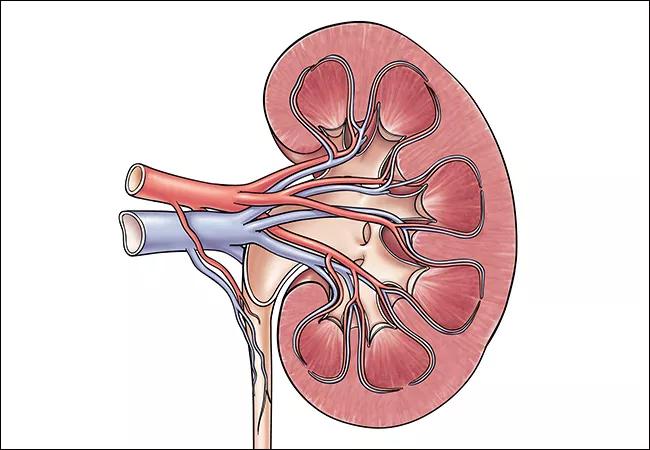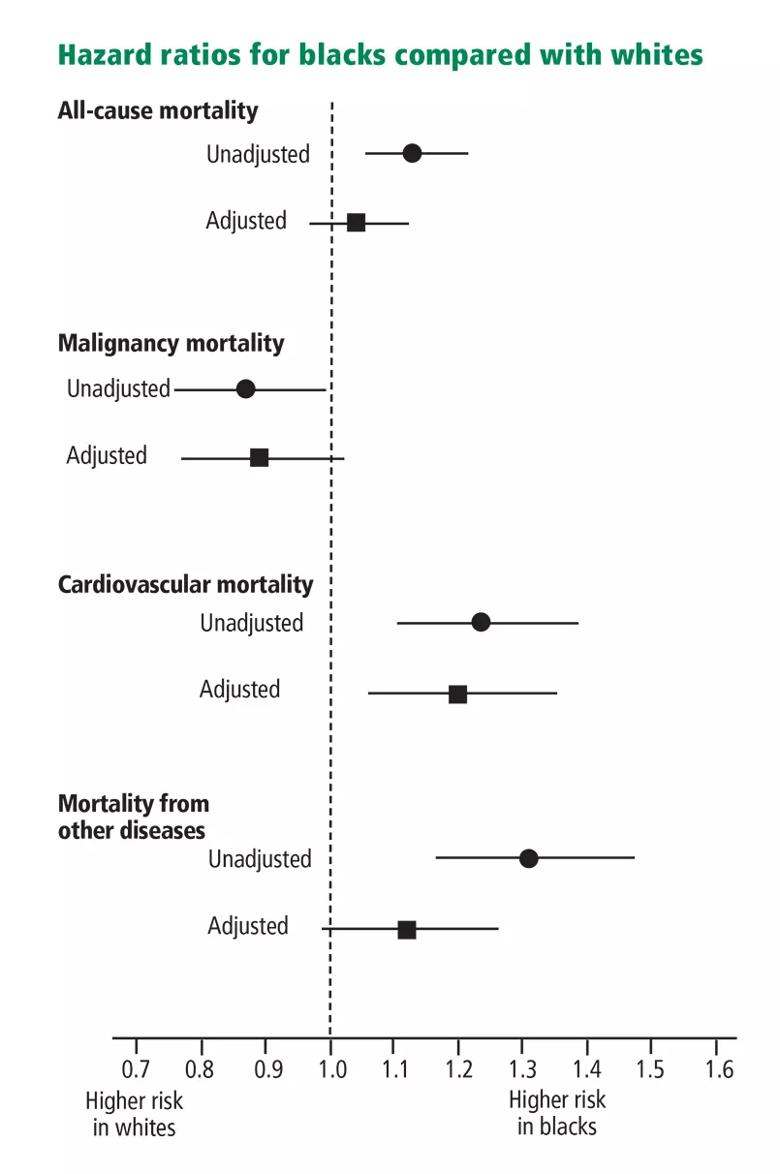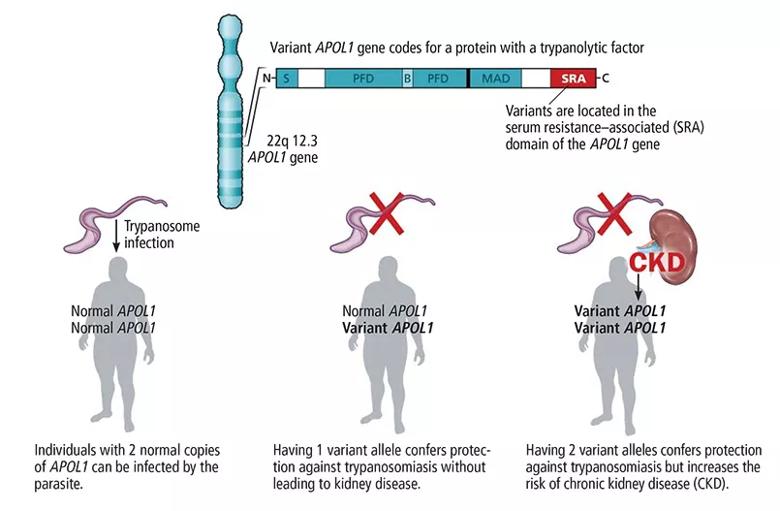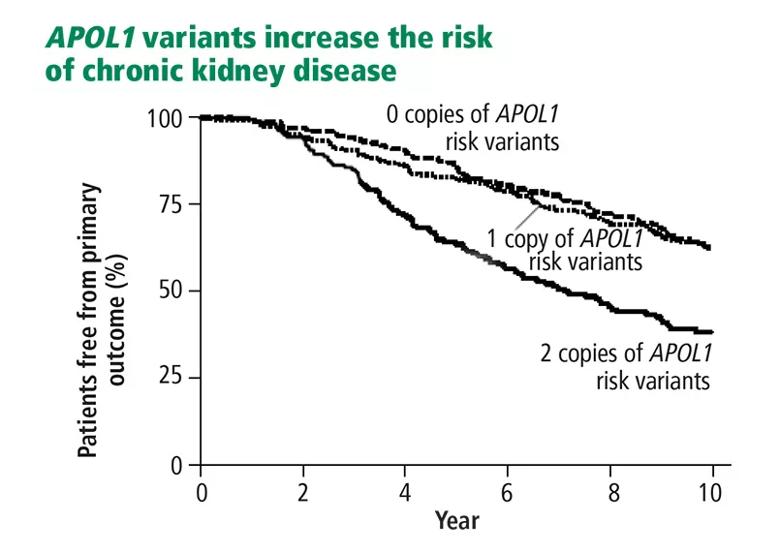Genetics, at least in part, drives renal disease outcomes in African-American patients

Cleveland Clinic is a non-profit academic medical center. Advertising on our site helps support our mission. We do not endorse non-Cleveland Clinic products or services. Policy
This is an abridged version of a November 2017 Cleveland Clinic Journal of Medicine article.
Editor’s note: This was a Medical Grand Rounds presented as the 14th Annual Lawrence “Chris” Crain Memorial Lecture, a series dedicated to discussing kidney disease, hypertension and health care disparities in the African-American community. In 1997, Dr. Crain became the first African-American chief medical resident at Cleveland Clinic, and was a nephrology fellow in 1998–1999. Dr. Nally was his teacher and mentor.
African-Americans have a greater burden of chronic kidney disease (CKD) than whites. They are more than three times as likely as whites to develop end-stage renal disease, even after adjusting for age, disease stage, smoking, medications and comorbidities. Why this is so has been the focus of much speculation and research.
African-Americans constitute about 12 percent of the U.S. population but account for:
In addition, African-Americans with CKD tend to be:

Adapted from Navaneethan SD, Schold JD, Arrigain S, Jolly SE, Nally JV Jr. Cause-specific deaths in non-dialysis-dependent CKD . J Am Soc Nephrol 2015; 26:2512–2520. Figure 1. Risk for all-cause and major cause-specific death in black versus white patients.
Although African-Americans have only a slightly higher prevalence of CKD than whites (about 15 percent increased prevalence), they are three times more likely to be on dialysis.
Yet for unknown reasons, African-American adults on dialysis have about a 26 percent lower all-cause mortality rate than whites. One proposed explanation for this survival advantage has been that the mortality rate in African-Americans with CKD before entering dialysis is higher than in whites, leading to a “healthier population” on dialysis. However, this theory was based on a small study from more than a decade ago and has not been borne out by subsequent investigation.
African-Americans over age 65 with CKD have all-cause mortality rates similar to those of whites: about 11 percent annually. Breaking it down by disease severity, death rates in stage 3 disease are about 10 percent and jump to more than 15 percent in higher stages in both African-Americans and whites.
However, African-Americans with CKD have more heart disease and much more end-stage renal disease than whites.
The incidence of end-stage renal disease is consistently more than three times higher in African-Americans than in whites in the U.S.
Multiple investigations have tried to determine why African-Americans are disproportionately affected by progression of CKD to end-stage renal disease. We recently examined this question using our Cleveland Clinic registry data.† Even after adjusting for 17 variables (including demographics, comorbidities, insurance, medications, smoking and CKD stage), African-Americans with CKD were found to have an increased risk of progressing to end-stage renal disease compared with whites (subhazard ratio 1.38, 95 percent confidence interval 1.19–1.60).
In terms of the number of laboratory tests ordered, clinic visits and nephrology referrals, African-Americans had at least as much care as whites, if not more. Similarly, African-Americans’ access to renoprotective medicines (angiotensin-converting enzyme inhibitors, angiotensin II receptor blockers, statins, beta-blockers) was the same as or more than for whites.
Although the frequently attributed reasons surrounding compliance and socioeconomic issues are worthy of examination, they do not appear to completely explain the differences in incidence and outcomes. This dichotomy of a marginally increased prevalence of CKD in African-Americans with mortality rates similar to those of whites, yet with a three times higher incidence of end-stage renal disease in African-Americans, suggests a faster progression of the disease in African-Americans that may be genetically based.
In 2010, two variant alleles of the APOL1 gene on chromosome 22 were found to be associated with nondiabetic kidney disease in African-Americans. Three nephropathies are associated with being homozygous for these alleles:
The first two conditions are three to five times more prevalent in African-Americans than in whites, and HIV-associated nephropathy is about 20 to 30 times more common.
The APOL1 variants have been linked to protection from African sleeping sickness caused by Trypanosoma brucei, transmitted by the tsetse fly (Figure 2). The pathogen can infect people with normal APOL1 using a serum resistance-associated protein, while the mutant variants prevent or reduce protein binding. Having one variant allele confers protection against trypanosomiasis without leading to kidney disease; having both alleles with the variants protects against sleeping sickness but increases the risk of CKD. About 15 percent of African-Americans are homozygous for a variant.

Figure 2. Variants in the APOL1 gene that are common in sub-Saharan Africa protect against African sleeping sickness, but homozygosity for these variants increases the risk of CKD.
The African-American Study of Kidney Disease and Hypertension (AASK) trial evaluated whether tighter blood pressure control would improve outcomes. Biologic samples were available for DNA testing for 693 of the 1,094 trial participants. Of these, 23 percent of African-Americans were found to be homozygous for a high-risk allele, and they had dramatically worse outcomes with greater loss of GFR than those with one or no variant allele (Figure 3). However, the impact of therapy (meeting blood pressure targets, treatment with different medications) did not differ between the groups.

Figure 3. Proportion of patients free from progression of CKD, according to APOL1 genotype, in the African-American Study of Kidney Disease and Hypertension. The primary outcome was reduction in the glomerular filtration rate (as measured by iothalamate clearance) or incident end-stage renal disease.
The Chronic Renal Insufficiency Cohort (CRIC) observation study enrolled patients with an estimated GFR of 20 to 70 mL/min/1.73 m2, with a preference for African-Americans and patients with diabetes. Nearly 3,000 participants had adequate samples for DNA testing. They found that African-Americans with the double variant allele had worse outcomes, whether or not they had diabetes, compared with whites and African-Americans without the homozygous gene variant.
In the kidney transplant arena, investigators have studied the fate of more than 100 kidneys that were transplanted from African-American donors, 16 percent of whom had the high-risk, homozygous genotype. In this case, graft failure was much likelier to occur with the high-risk donor kidneys (hazard ratio 3.84, P = .008). Similar outcomes were shown in a study of two centers involving 675 transplants from deceased donors, 15 percent of which involved the high-risk genotype. The National Institutes of Health are currently funding prospective longitudinal studies with the APOL1 Long-term Kidney Transplantation Outcomes Network (APOLLO) to determine the impact of APOL1 genetic factors on transplant recipients as well as on living donors.
The mechanism of renal injury is not well understood. Apolipoprotein L1, the protein coded for by APOL1, is a component of high-density lipoprotein. It is found in a different distribution pattern in people with normal kidneys versus those with nondiabetic kidney disease, especially in the arteries, arterioles and podocytes. It can be detected in blood plasma, but levels do not correlate with kidney disease. Not all patients with the high-risk variant develop CKD; a “second hit” such as infection with HIV may be required.
Investigators have recently developed knockout mouse models of APOL1-associated kidney diseases that are helping to elucidate mechanisms.
O’Toole et al (now at Cleveland Clinic) offered insightful observations regarding the potential clinical impact of these new genetic discoveries, and recommend that we keep in mind three critical clinical questions:
Dr. Nally is former Director, Center for Chronic Kidney Disease; Clinical Professor of Medicine, Cleveland Clinic Lerner College of Medicine of Case Western Reserve University
† Cleveland Clinic has developed a validated CKD registry based on its electronic health record. The data include demographics (age, sex, ethnic group), comorbidities, medications, and complete laboratory data.
Select References
(Full references for this article are included in the unabridged version in the Cleveland Clinic Journal of Medicine.)
Navaneethan SD, Jolly SE, Schold JD, et al. Development and validation of an electronic health record-based chronic kidney disease registry. Clin J Am Soc Nephrol 2011; 6:40–49.
Navaneethan SD, Schold JD, Arrigain S, Jolly SE, Nally JV Jr. Cause-specific deaths in non-dialysis-dependent CKD. J Am Soc Nephrol 2015; 26:2512–2520.
Madhavan SM, O’Toole JF, Konieczkowski M, Ganesan S, Bruggeman LA, Sedor JR. APOL1 localization in normal kidney and nondiabetic kidney disease. J Am Soc Nephrol 2011; 22:2119–2128.
Bruggeman LA, O’Toole JF, Ross MD, et al. Plasma apolipoprotein L1 levels do not correlate with CKD. J Am Soc Nephrol 2014; 25:634–644.
O’Toole JF, Bruggeman LA, Sedor JR. A new mouse model of APOL1-associated kidney diseases: when traffic gets snarled the podocyte suffers. Am J Kidney Dis 2017; pii: S0272-6386(17)30808-9. doi: 10.1053/j.ajkd.2017.07.002. [Epub ahead of print]

Clinicians should individualize dosing practices based on patient risk factors and preferences

Fully-automated process uses preop CT, baseline GFR to estimate post-nephrectomy renal function

Could mean earlier treatment, but also could have negative effects

Identifying barriers in the renal genetic assessment of Black patients

Getting patients to their goal blood pressure

Study highlights benefits of nephrologist-led urine sediment analysis

Using sequencing data to identify novel factors linked to kidney disease with unknown origin

Program plays key role in diagnosis and management of genetic kidney diseases